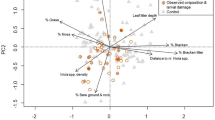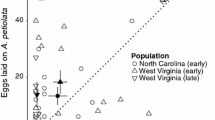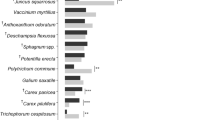Abstract
Female oviposition decisions in insects may strongly affect offspring growth and survival, and thus determine population performance. In this study, we examined oviposition site selection in the xerophilous ecotype of the endangered myrmecophilous butterfly Phengaris (=Maculinea) alcon (Lepidoptera, Lycaenidae) in Estonia, at the northern distribution margin of both the butterfly and its host plant, Gentiana cruciata L. Egg distribution on individual host plants appeared to be highly uneven: plants carrying high egg loads contrasted to a high proportion of host plants without any or with a few eggs. Host plant use for oviposition was strongly dependent on plant characteristics and environmental context. Host plant height relative to the surrounding vegetation rather than the absolute height of host plants was a key factor determining the use of particular host plant individuals for oviposition. In particular, plants protruding above surrounding vegetation had a higher probability of being used for oviposition, and carried more eggs. Additionally, the number of eggs laid on individual host plants was positively associated with the presence of flowers and the number of shoots. More aggregated host plants received fewer eggs than those with less conspecifics around. Feeding damage by wild herbivores, found in a substantial proportion of the butterfly’s host plants, strongly reduced the number of eggs on individual plants. Our results underline the need to assure that butterfly’s host plants do not become overgrown by surrounding vegetation. Best practices for opening vegetation around host plants may need further studies that explicitly account for butterfly’s host ants—their abundance in relation to vegetation height and their response to opening vegetation.

Similar content being viewed by others
References
Als TD, Vila R, Kandul NP, Nash DR, Yen SH, Hsu YF, Mignault AA, Boomsma JJ, Pierce NE (2004) The evolution of alternative parasitic life histories in large blue butterflies. Nature 432:386–390
Arnaldo PS, Wynhoff I, Soares P, da Conceição Rodrigues M, Aranha J, Csosz S, Maravalhas E, Tartally A (2011) Maculinea alconexploitsMyrmica alobain Portugal: unusual host ant species of a myrmecophilous butterfly in a peripheral region. J Insect Conserv 15:465–467
Árnyas E, Bereczki J, Tóth A, Pecsenye K, Varga Z (2006) Egg-laying preferences of the xerophilous ecotype of Maculinea alcon (Lepidoptera: Lycaenidae) in the Aggtelek National Park. Eur J Entomol 103:587–595
Bahn V, O’Connor RJ, Krohn WB (2006) Effect of dispersal at range edges on the structure of species ranges. Oikos 115:89–96
Balmer O, Erhardt A (2000) Consequences of succession on extensively grazed grasslands for Central European butterfly communities: rethinking conservation practices. Conserv Biol 14:746–757
Bartoń K (2013) Package “MuMIn”: multi-model inference. R package version 1.9.13. R Foundation for Statistical Computing, Vienna
Baylis M, Pierce NE (1991) The effect of host-plant quality on the survival of larvae and oviposition by adults of an ant-tended lycaenid butterfly, Jalmenus evagoras. Ecol Entomol 16:1–9
Bereczki J, Pecsenye K, Peregovits L, Varga Z (2005) Pattern of genetic differentiation in the Maculinea alcon species group (Lepidoptera, Lycaenidae) in Central Europe. J Zool Syst Evol Res 43:157–165
Bereczki J, Pecsenye K, Varga Z (2006) Geographical versus food plant differentiation in populations of Maculinea alcon (Lepidoptera: Lycaenidae) in Northern Hungary. Eur J Entomol 103:725–732
Bergström A (2005) Oviposition site preferences of the threatened butterfly Parnassius mnemosyne—implications for conservation. J Insect Conserv 9:21–27
Bridle JR, Buckley J, Bodsworth EJ, Thomas CD (2014) Evolution on the move: specialization on widespread resources associated with rapid range expansion in response to climate change. Proc R Soc B 281:20131800
Burnham KP, Anderson DR (2002) Model selection and multimodel inference: a practical information-theoretic approach. Springer, New York
Capman WC, Batzli GO, Simms LE (1990) Response of the common sooty wing skipper to patches of host plants. Ecology 71:1430–1440
Cardinale BJ, Duffy E, Conzalez A, Hooper DU, Perrings C, Venail P, Narwani A, Mace GM, Tilman D, Wardle DA, Kinzig AP, Daily CG, Loreau M, Grace JB, Larigauderie A, Srivastava D, Naeem S (2012) Biodiversity loss and its impact on humanity. Nature 486:59–67
Casacci LP, Witek M, Barbero F, Patricelli D, Solazzo G, Balletto E, Bonelli S (2011) Habitat preferences of Maculinea arion and its Myrmica host ants: implications for habitat management in Italian Alps. J Insect Conserv 15:103–110
Chew FS, Courtney SP (1991) Plant apparency and evolutionary escape from insect herbivory. Am Nat 138:729–750
Clarke RT, Thomas JA, Elmes G, Wardlaw JC, Munguira ML, Hochberg ME (1998) Population modelling of the spatial interactions between Maculinea rebeli, their initial foodplant Gentiana cruciata and Myrmica ants within a site. J Insect Conserv 2:29–37
Courtney SP (1982) Coevolution of pierid butterflies and their cruciferous foodplants. IV. Crucifer apparency and Anthocharis cardamines (L.) oviposition. Oecologia 52:258–265
Czekes Z, Markó B, Nash DR, Ferencz M, Lázár B, Rákosy L (2014) Differences in oviposition strategies between two ecotypes of the endangered myrmecophilous butterfly Maculinea alcon (Lepidoptera: Lycaenidae) under unique syntopic conditions. Insect Conserv Divers 7:122–131
Doak P, Kareiva P, Kingsolver J (2006) Fitness consequences of choosy oviposition for a time-limited butterfly. Ecology 87:395–408
Dolek M, Geyer A, Bolz R (1998) Distribution of Maculinea rebeli and host plant use on sites along the river Danube. J Insect Conserv 2:85–89
Elmes GW, Clarke RT, Wardlaw JC (1991) Larvae of Maculinea rebeli, a large blue butterfly, and their Myrmica host ants: patterns of caterpillar growth and survival. J Zool 224:447–460
Elmes GW, Thomas JA, Wardlaw JC, Hochberg ME, Clarke RT, Simcox DJ (1998) The ecology of Myrmica ants in relation to the conservation of Maculinea butterflies. J Insect Conserv 2:67–78
Fahrig L (2003) Effects of habitat fragmentation on biodiversity. Annu Rev Ecol Evol Syst 34:487–515
Fric Z, Wahlberg N, Pech P, Zrzavỳ J (2007) Phylogeny and classification of the Phengaris-Maculinea clade (Lepidoptera: Lycaenidae): total evidence and phylogenetic species concepts. Syst Entomol 32:558–567
GBIF Backbone Taxonomy (2016) doi:10.15468/39omei. Accessed 28 Oct 2016
Heisswolf A, Obermaier E, Poethke HJ (2005) Selection of large host plants for oviposition by a monophagous leaf beetle: nutritional quality or enemy-free space? Ecol Entomol 30:299–306
Hochberg ME, Thomas JA, Elmes GW (1992) A modelling study of the population dynamics of a large blue butterfly, Maculinea rebeli, a parasite of red ant nests. J Anim Ecol 61:397–409
Holt RD, Keitt TH (2005) Species’ border: a unifying theme in ecology. Oikos 108:3–6
Konvička M, Benes J, Cizek O, Kopecek F, Konvička O, Vitaz L (2008) How too much care kills species: grassland reserves, agri-environmental schemes and extinction of the Colias myrmidone butterfly from its former stronghold. J Insect Conserv 12:519–525
Körösi A, Örvössy N, Batáry P, Kövér S, Pergovits L (2008) Restricted within-habitat movement and time-constrained egg laying of female Maculinea rebeli butterflies. Oecologia 156:455–464
Krehenwinkel H, Tautz D (2013) Northern range expansion of European populations of the wasp spider Argiope bruennichi is associated with global warming-correlated genetic admixture and population-specific temperature adaptations. Mol Ecol 22:2232–2248
Küer A, Fartmann T (2005) Prominent shoots are preferred: microhabitat preferences of Maculinea alcon [(Denis and Schiffermüller), 1775] in Northern Germany (Lycaenidae). Nota Lepidopterol 27:309–319
Kukk T, Kull T (2005) Eesti taimede levikuatlas. Atlas of the Estonian flora. EMÜ põllumajandus- ja keskkonnainstituut, Tartu
Maes D, van Dyck H, Vanreusel W, Talloen W (2004) Functional conservation units for the endangered butterfly Maculinea alcon in Belgium (Lepidoptera: Lycaenidae). Biol Conserv 120:233–245
Mattila N, Kaitala V, Komonen A, Päivinen J, Kotiaho JS (2011) Ecological correlates of distribution change and range shift in butterflies. Insect Conserv Divers 4:239–246
Meyer-Hozak C (2000) Population biology of Maculinea rebeli (Lepidoptera: Lycaenidae) on chalk grasslands of Eastern Westphalia (Germany) and implications for conservation. J Insect Conserv 4:63–72
Moritz C, Langham G, Kearney M, Krockenberger A, VanDerWal J, Williams S (2012) Integrating phylogeography and physiology reveals divergence of thermal traits between central and peripheral lineages of tropical rainforest lizards. Philos Trans R Soc B 367:1680–1687
Nowicki P, Witek M, Skórka P, Woyciechowski M (2005) Oviposition patterns in the myrmecophilous butterfly Maculinea alcon Denis and Schiffermüller (Lepidoptera: Lycaenidae) in relation to characteristics of foodplants and presence of ant hosts. Pol J Environ 53:409–417
Oškinis V (2012) Relationship between the butterfly Phengaris rebeli and its larval host plant Gentiana cruciata in Lithuanian population. Ekologija 58:369–373
Osváth-Ferencz M, Czekes Z, Molnár G, Markó B, Vizauer T-Z, Rákosy L, Nowicki P (2016) Adult population ecology and egg laying strategy in the “cruciata” ecotype of the endangered butterfly Maculinea alcon (Lepidoptera: Lycaenidae). J Insect Conserv 20:255–264
Paradis E, Claude J, Strimmer K (2004) APE: analyses of phylogenetics and evolution in R language. Bioinformatics 20:289–290
Pech P, Fric Z, Konvička M, Zrzavý J (2004) Phylogeny of Maculinea blues (Lepidoptera: Lycaenidae) based on morphological and ecological characters: evolution of parasitic myrmecophily. Cladistics 20:362–375
Pecsenye K, Bereczki J, Tihanyi B, Tóth A, Pergovits L, Varga ZS (2007) Genetic differentiation among the Maculinea species (Lepidoptera: Lycaenidae) in eastern Central Europe. Biol J Linn Soc 91:11–21
Pereira HM, Leadley PW, Proença V, Alkemade R, Scharlemann JPW, Fernandez-Manjarrés JF, Araújo MB, Balvanera P, Biggs R, Cheung WWL, Chini L, Cooper HD, Gilman EL, Guénette S, Hurtt GC, Huntington HP, Mace GM, Oberdorff T, Revenga C, Rodrigues P, Scholes RJ, Sumaila UR, Walpole M (2010) Scenarios for global biodiversity in the 21st century. Science 330:1496–1501
Pierce NE, Elgar MA (1985) The influence of ants on host plant selection by Jalmenus evagoras, a myrmecophilous lycaenid butterfly. Behav Ecol Sociobiol 16:202–222
Porter K (1992) Eggs and egg-laying. In: Dennis RLH (ed) The ecology of butterflies in Britain. Oxford University Press, Oxford, pp 46–72
R Development Core Team (2014) R: a language and environment for statistical computing. R Foundation for Statistical Computing, Vienna
Settele J, Kühn E, Thomas J (eds) (2005) Studies on the ecology and conservation of butterflies in Europe. Volume 2: species ecology along a European gradient: Maculinea butterflies as a model. Pensoft, Sofia
Shreeve TG (1986) Egg-laying by the speckled wood butterfly (Pararge aegeria): the role of female behaviour, host plant abundance and temperature. Ecol Entomol 11:229–236
Sielezniew M, Rutkowski R, Ponikwicka D, Ratkiewicz M, Dziekańska I, Švitra G (2012) Differences in genetic variability between two ecotypes of endangered myrmecophilous butterfly Phengaris (=Maculinea) alcon—the setting of conservation priorities. Insect Conserv Divers 5:223–236
Steiner FM, Sielezniew M, Schlick-Steiner BC, Höttinger A, Stankiewicz H, Górnicki A (2003) Host specificity revisited: new data on Myrmica host ants of the lycaenid butterfly Maculinea rebeli. J Insect Conserv 7:1–6
Stewart KEJ, Bourn NAD, Thomas JA (2001) An evaluation of three quick methods commonly used to assesss height in ecology. J Appl Meteorol 38:1148–1154
Thomas JA (1991) Rare species conservation: case studies of European butterflies. In: Spellerberg IF, Goldsmith FB, Morris MG (eds) The scientific management of temperate communities for conservation. Blackwell Scientific, Oxford, pp 149–197
Thomas JA, Elmes GW (2001) Food-plant niche selection rather than the presence of ant nests explains oviposition patterns in the myrmecophilous butterfly genus Maculinea. Proc R Soc B 268:471–477
Thomas JA, Elmes GW, Wardlaw JC, Woyciechowski M (1989) Host specificity among Maculinea butterflies in Myrmica ant nests. Oecologia 79:452–457
Thomas JA, Munguira ML, Martin J, Elmes GW (1991) Basal hatching by Maculinea butterfly eggs: a consequence of advanced myrmecophily? Biol J Linn Soc 44:175–184
Thomas JA, Simcox DJ, Clarke RT (2009) Successful conservation of a threatened Maculinea butterfly. Science 325:80–83
Thompson JN, Price PW (1977) Plant plasticity, phenology, and herbivore dispersion: wild parsnip and the parsnip webworm. Ecology 58:1112–1119
Tscharntke T, Steffan-Dewenter I, Kruess A, Thies C (2002) Characteristics of insect populations on habitat fragments: a mini review. Ecol Res 17:229–239
Van Dyck H, Regniers S (2010) Egg spreading in the ant-parasitic butterfly, Maculinea alcon: from individual behaviour to egg distribution pattern. Anim Behav 80:621–627
Van Dyck H, Oostermeijer JG, Talloen W, Feenstra V, van der Hidde A, Wynhoff I (2000) Does the presence of ant nests matter for oviposition to a specialized myrmecophilous Maculinea butterfly? Proc R Soc B 267:861–866
Van Swaay C, Warren M, Loïs G (2005) Biotope use and trends of European butterflies. J Insect Conserv 10:189–209
Van Dyck H, Van Strien AJ, Maes D, Van Swaay C (2009) Declines in common, widespread butterflies in a landscape under intense human use. Conserv Biol 23:957–965
Vilbas M, Esperk T, Teder T (2016) Host ant use of the Alcon blue butterfly at the northern range margin. J Insect Conserv 20:879–886
Virtanen T, Neuvonen S (1999) Climate change and macrolepidopteran biodiversity in Finland. Chemosphere Glob Change Sci 1:439–448
WallisDeVries MF (2004) A quantitative conservation approach for the endangered butterfly Maculinea alcon. Conserv Biol 18:489–499
Waring P (2001) Grazing and cutting as conservation management tools: the need for cautious approach, with some examples of rare moths which have been adversely affected. Entomol Rec J Var 113:193–200
Wiklund C (1984) Egg-laying patterns in butterflies in relation to their phenology and the visual apparency and abundance of their host plants. Oecologia 63:23–29
Wiklund C, Friberg M (2008) Enemy-free space and habitat-specific host specialization in a butterfly. Oecologia 157:287–294
Wynhoff I, Bakker RB, Oteman B, Seixas Arnaldo P, Van Langevelde F (2015) Phengaris (Maculinea) alcon butterflies deposit their eggs on tall plants with many large buds in the vicinity of Myrmica ants. Insect Conserv Divers 8:177–188
Zuur AF, Ieno EN, Elphick CS (2010) A protocol for data exploration to avoid common statistical problems. Methods Ecol Evol 1:3–14
Acknowledgements
We are grateful to Kertu Jaik for assistance in the field. We would also like to thank Jani Palén for kindly introducing the Alcon blue population to the authors, and Allan Nurk for letting us work on his property. This study was supported by institutional research funding (Grant No. IUT20-33) of the Estonian Ministry of Education and Research, and by the European Union through the European Regional Development Fund (Center of Excellence FIBIR).
Author information
Authors and Affiliations
Corresponding author
Rights and permissions
About this article
Cite this article
Vilbas, M., Esperk, T., Edovald, T. et al. Oviposition site selection of the Alcon blue butterfly at the northern range margin. J Insect Conserv 20, 1059–1067 (2016). https://doi.org/10.1007/s10841-016-9939-x
Received:
Accepted:
Published:
Issue Date:
DOI: https://doi.org/10.1007/s10841-016-9939-x




